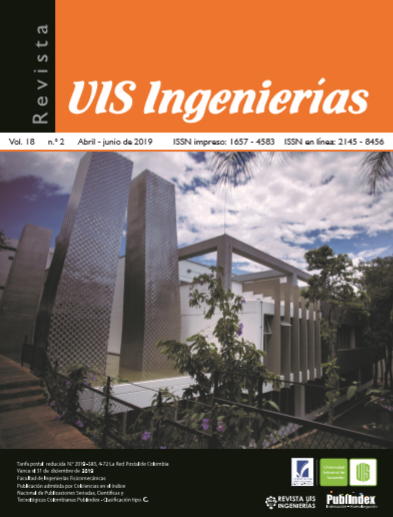Assessment of cohesive traction-separation relationship according stiffness variation
Published 2019-01-28
Keywords
- Abaqus,
- cohesive element,
- cohesive zone model,
- finite element simulation,
- traction separation law
How to Cite
Abstract
The definition of a traction-separation relationship is a fundamental issue in cohesive zone models because it describes the nonlinear fracture process. Cohesive interactions are generally a function of displacement jump (or separation). If the displacement jump is greater than a characteristic length (dn), complete failure occurs. In this study, the softening condition behavior of a cohesive interface between two identical materials was assessed for different stiffness values of solid and cohesive. The cohesive interface was modeled with a traction-separation linear relationship and for the solids continuum elastic constitutive models were used. The softening condition was obtained by analytical and finite element method. The whole system behavior was modeled using ABAQUS 6.14 to obtain stress-displacement relationship. The analytical solution and computational results were compared. The computational results matched the analytical solutions and the simulations allowed to obtain a response in the cases where the analytical solution has singularities “backslash effect”.
Downloads
References
V. Tvergaard and J. W. Hutchinson, “The relation between crack growth resistance and fracture process parameters in elastic-plastic solids,” J. Mech. Phys. Solids, vol. 40, no. 6, pp. 1377–1397, 1992.
X.-P. Xu and A. Needleman, “Numerical simulations of fast crack growth in brittle solids,” J. Mech. Phys. Solids, vol. 42, no. 9, pp. 1397–1434, 1994.
P. P. Camanho, C. G. Davila, and M. F. de Moura, “Numerical Simulation of Mixed-Mode Progressive Delamination in Composite Materials,” J. Compos. Mater., vol. 37, no. 16, pp. 1415–1438, 2003.
V. Tvergaard and J. W. Hutchinson, “The influence of plasticity on mixed mode interface toughness,” J. Mech. Phys. Solids, vol. 41, no. 6, pp. 1119–1135, 1993.
P. H. Geubelle and J. S. Baylor, “Impact-induced delamination of composites: a 2D simulation,” Compos. Part B Eng., vol. 29, no. 5, pp. 589–602, 1998.
K. Park, H. Choi, and G. H. Paulino, “Assessment of cohesive traction-separation relationships in ABAQUS: A comparative study,” Mech. Res. Commun., vol. 78, pp. 71–78, 2016.
G. H. Paulino, “Cohesive Zone Models: A Critical Review of Traction-Separation Relationships Across Fracture Surfaces,” Appl. Mech. Rev., vol. 64, no. 6, 2011. doi: 10.1115/1.4023110.
V. Tvergaard and J. W. Hutchinson, “The relation between crack growth resistance and fracture process parameters in elastic-plastic solids,” J. Mech. Phys. Solids, vol. 40, no. 6, pp. 1377–1397, 1992. doi: 10.1002/cnm.717.
D. S. Dugdale, “Yielding of steel sheets containing slits,” J. Mech. Phys. Solids, vol. 8, no. 2, pp. 100–104, 1960. doi: 10.1016/0022-5096(60)90013-2.
G. I. Barenblatt, “The Mathematical Theory of Equilibrium Cracks in Brittle Fracture,”, , vol. 7, H. L. Dryden, T. von Kármán, G. Kuerti, F. H. van den Dungen, and L. Howarth, Eds. Elsevier, 1962, pp. 55–129. doi: 10.1016/S0065-2156(08)70121-2.
A. Needleman, “An analysis of decohesion along an imperfect interface,” Int. J. Fract., vol. 42, no. 1, pp. 21–40, Jan. 1990. doi: 10.1007/BF00018611.
M. Alfano, F. Furgiuele, A. Leonardi, C. Maletta, and G. H. Paulino, “Cohesive Zone Modeling of Mode I Fracture in Adhesive Bonded Joints,” Key Eng. Mater., vol. 348, pp. 13–16, 2007. doi: 10.4028/www.scientific.net/KEM.348-349.13.
K. Park and G. H. Paulino, “Computational implementation of the PPR potential-based cohesive model in ABAQUS: Educational perspective,” Eng. Fract. Mech., vol. 93, pp. 239–262, 2012. doi: 10.1016/j.engfracmech.2012.02.007.
N. Chandra, H. Li, C. Shet, and H. Ghonem, “Some issues in the application of cohesive zone models for metal–ceramic interfaces,” Int. J. Solids Struct., vol. 39, no. 10, pp. 2827–2855, 2002. doi: 10.1016/S0020-7683(02)00149-X.
I. Scheider, “Cohesive model for crack propagation analyses of structures with elastic–plastic material behavior Foundations and implementation,” GKSS research center Geesthach, Teltow, apr. 2001.
Abaqus 6.14 Analysis User’s Manual, Dassault Sistemes, Simulya, 2014.

